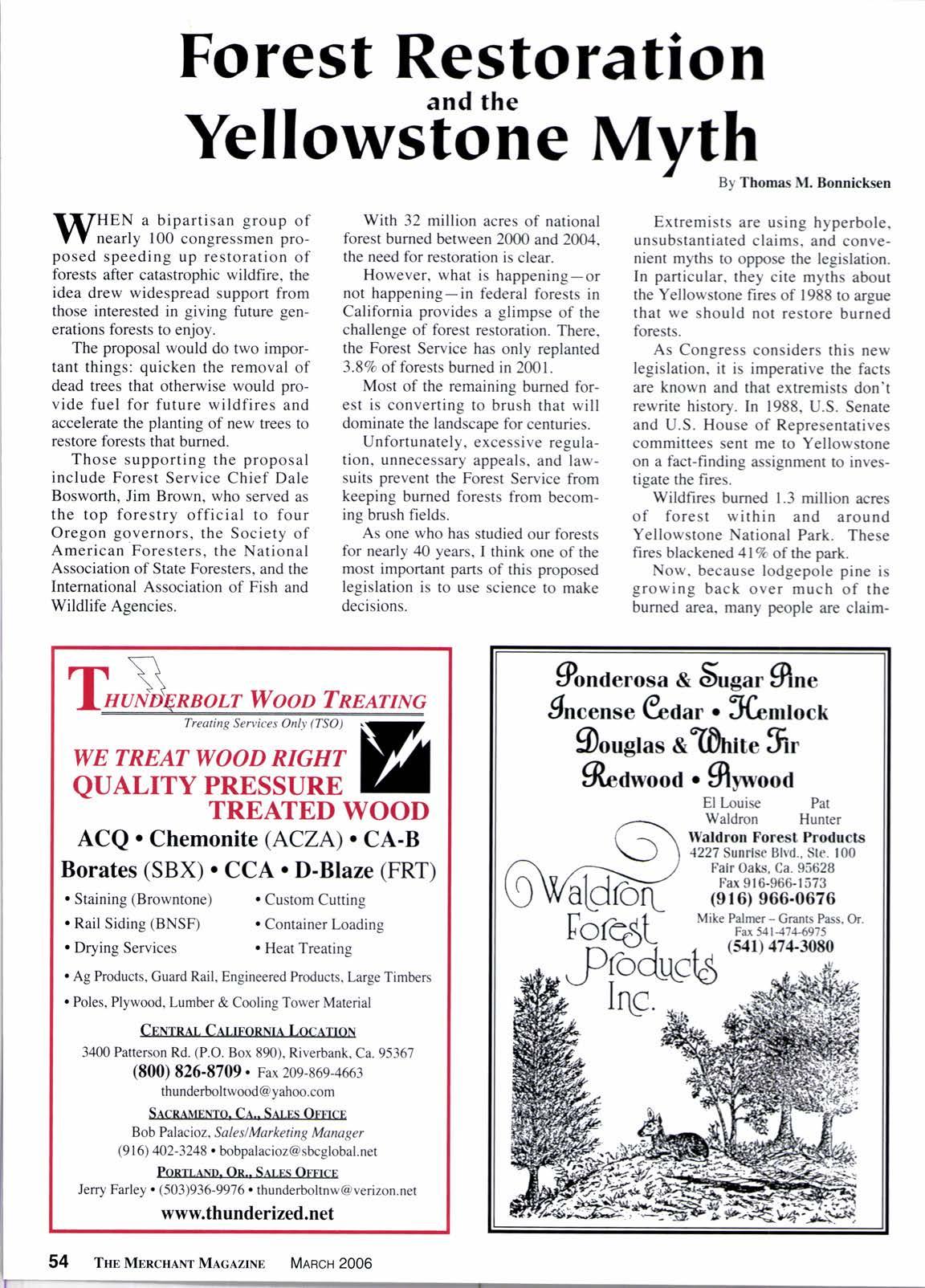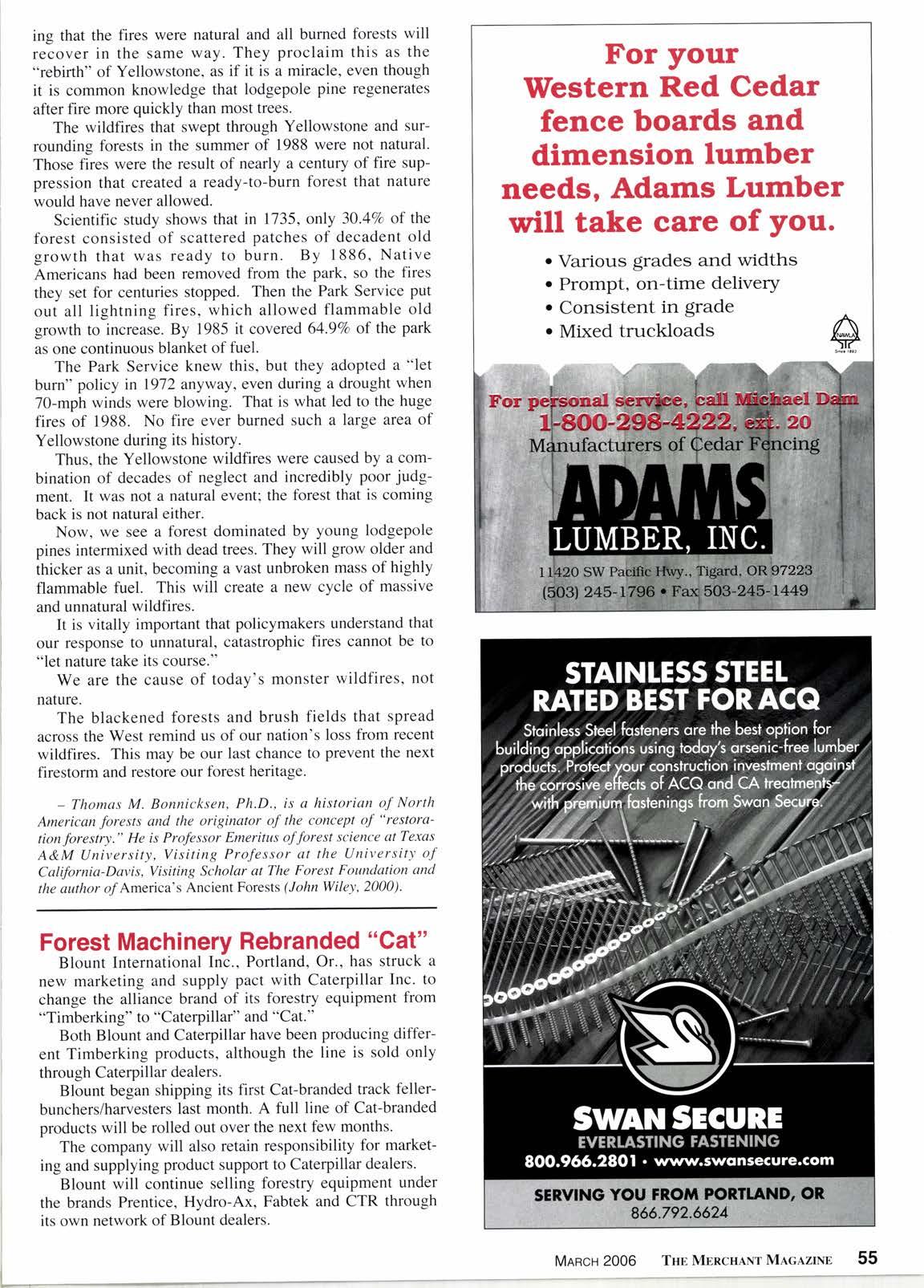
4 minute read
Forest RestoYation Yellowstiih" Mvth I
Itr/HEN a bipartisan group of V Y nearly 100 congressmen proposed speeding up restoration of forests after catastrophic wildfire, the idea drew widespread support from those interested in giving future generations forests to enjoy.
The proposal would do two important things: quicken the removal of dead trees that otherwise would provide fuel for future wildfires and accelerate the planting of new trees to restore forests that burned.
Those supporting the proposal include Forest Service Chief Dale Bosworth. Jim Brown. who served as the top forestry official to four Oregon governors, the Society of American Foresters, the National Association of State Foresters, and the International Association of Fish and Wildlife Agencies.
With 32 million acres of national forest burned between 2000 and 2004. the need for restoration is clear.
However. what is happening-or not happening-in federal forests in California provides a glimpse of the challenge of forest restoration. There, the Forest Service has only replanted 3.87o of forests burned in 2001.
Most of the remaining burned forest is converting to brush that will dominate the landscape for centuries.
Unfortunately, excessive regulation, unnecessary appeals, and lawsuits prevent the Forest Service from keeping burned forests from becoming brush fields.
As one who has studied our forests for nearly 40 years, I think one of the most important parts of this proposed legislation is to use science to make decisions.
Bv Thomas M. Bonnicksen
Extremists are using hyperbole, unsubstantiated claims. and convenient myths to oppose the legislation. In particular, they cite myths about the Yellowstone fires of 1988 to argue that we should not restore burned forests.
As Congress considers this new legislation, it is imperative the facts are known and that extremists don't rewrite history. In 1988, U.S. Senate and U.S. House of Representatives committees sent me to Yellowstone on a fact-finding assignment to investigate the fires.
Wildfires burned 1.3 million acres of forest within and around Yellowstone National Park. These fires bfackened 4l% of the park. Now, because lodgepole pine is growing back over much of the burned area, many people are claim-
Treating
ACQ. Chemonite (ACZA). CA-B
Borates (SBX) . CCA . D-Blaze (FRT)
Staining (Browntone) . Custom Cutting
Rail Siding (BNSF)
Drying Services
. Container Loading Heat Treatins
Ag Products, Guard Rail, Engineered Products, Large Timbers
Poles, Plywood, Lumber & Cooling Tower Material
Ctxrnar CALrnowa Loclrrort
3400 Panerson Rd. (P.O. Box 890), Riverbank, Ca.95367 (800) 826-8709. Fax 20e-86e-4663 thunderboltwood @ yahoo.com
Sacuunrvro. Cl.. Slr ns (lpncr'
Bob Palacioz, Sale s/ Marketing Manager (9 rc) 442-3248. bobpalacioz@sbcglobal.net
Pon'u axn. On.. Srr ps Orncn
Jerry Farley (503)936-9976 thunderboltnw@verizon.ner www.thunderized.net ing that the fires were natural and all bumed forests will recover in the same way. They proclaim this as the "rebirth" of Yellowstone, as if it is a miracle, even though it is common knowledge that lodgepole pine regenerates after fire more quickly than most trees.
The wildfires that swept through Yellowstone and surrounding forests in the summer of 1988 were not natural. Those fires were the result of nearly a century of fire suppression that created a ready-to-burn forest that nature would have never allowed.
Scientific study shows that in 1735, only 3O.4Vo of the forest consisted of scattered patches of decadent old growth that was ready to burn. By 1886, Native Americans had been removed from the park, so the fires they set for centuries stopped. Then the Park Service put out all lightning fires, which allowed flammable old growth to increase. By 1985 it covered 64.9Vo of the park as one continuous blanket of fuel.
The Park Service knew this, but they adopted a "let burn" policy in 1972 anyway, even during a drought when 70-mph winds were blowing. That is what led to the huge fires of 1988. No fire ever burned such a large area of Yellowstone during its history.
Thus, the Yellowstone wildfires were caused by a combination of decades of neglect and incredibly poor judgment. It was not a natural event; the forest that is coming back is not natural either.
Now, we see a forest dominated by young lodgepole pines intermixed with dead trees. They will grow older and thicker as a unit, becoming a vast unbroken mass of highly flammable fuel. This will create a new cycle of massive and unnatural wildfires.
It is vitally important that policymakers understand that our response to unnatural, catastrophic fires cannot be to "let nature take its course."
We are the cause of today's monster wildfires, not nature.
The blackened forests and brush fields that spread across the West remind us of our nation's loss from recent wildfires. This may be our last chance to prevent the next firestorm and restore our forest heritage.
- Thomas M. Bonnicksen, Ph.D., is a historian of North American forests and the originator of the concept of "restora' tion.forestry." He is Professor Emeritus offorest science atTexas A&M University, Visiting Professor at the University of Califurnia-Davis, Visiting Scholar at The Forest Foundation and the author of America's Ancient Forests (John Wiley,2000)'
Forest Machinerv Rebranded "Cat"
Blount International In-c., Portland, Or., has struck a new marketing and supply pact with Caterpillar Inc. to change the alliance brand of its forestry equipment from "Timberking" to "Caterpillar" and "Cat."
Both Blount and Caterpillar have been producing different Timberking products, although the line is sold only through Caterpillar dealers.
Blount began shipping its first Cat-branded track fellerbunchers/harvesters last month. A full line of Cat-branded products will be rolled out over the next few months.
The company will also retain responsibility for marketing and supplying product support to Caterpillar dealers.

Blount will continue selling forestry equipment under the brands Prentice, Hydro-Ax, Fabtek and CTR through its own network of Blount dealers.
Various grades and widths
. Prompt, on-time delivery o Consistent in grade o Mixed truckloads










